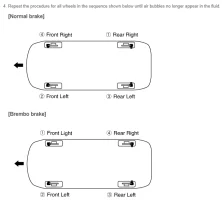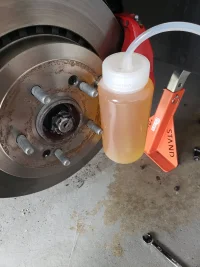Rynil2000
Stinger Enthusiast
I have decided the next planned upgrade on my GT1 is going to be the brake system. After a few hard runs through the mountain twisties over the past two years, the junk NA OEM pads have left their mark (literally) on the rotors and are causing the dreaded vibration. I have give them the temporary fix through aggressive re-bedding, but it's become a more frequent occurrence. With some interest in trying a couple of track days and wanting a better pedal feel and stopping power overall, my goal is to swap out to the Cquence slotted rotors, EBC Yellow Stuff all around, and Stoptech SS lines.
Along with all of the upgrades I'll need to bleed the brakes with some new DOT4 fluid. This is where I had some questions:
1. I am referencing the Kia Stinger CK 2018-2021 Service Manual / Brake Bleeding Procedures document, which lists the steps to do the work. However, the bleed order of the calipers is listed in an odd order. See below:

I've never seen a car that didn't follow the [Normal brake] procedure. Can anyone confirm that this method is accurate?
As a note, each Brembo caliper has two bleed screws. The inner most screw should be bled first, followed by the outer for each caliper.
2. I'd like the make the process a little easier on myself and use a Motive Power Bleeder system.
@scy started a good writeup on Non-Brembo Brake Bleeding and mentions that the model 0107 for Ford/Asian cars fit his reservoir. Can anyone confirm if it is the same fit for the 3.3L?
The Motive Application Guide and some Amazon reviews suggest that it may be, but just looking to see if others had experience on their GT. Inspecting the cap also leads me to think that the 0107 is the correct model so this is less of an issue that the weird bleed order above.
Along with all of the upgrades I'll need to bleed the brakes with some new DOT4 fluid. This is where I had some questions:
1. I am referencing the Kia Stinger CK 2018-2021 Service Manual / Brake Bleeding Procedures document, which lists the steps to do the work. However, the bleed order of the calipers is listed in an odd order. See below:

I've never seen a car that didn't follow the [Normal brake] procedure. Can anyone confirm that this method is accurate?
As a note, each Brembo caliper has two bleed screws. The inner most screw should be bled first, followed by the outer for each caliper.
2. I'd like the make the process a little easier on myself and use a Motive Power Bleeder system.
@scy started a good writeup on Non-Brembo Brake Bleeding and mentions that the model 0107 for Ford/Asian cars fit his reservoir. Can anyone confirm if it is the same fit for the 3.3L?
The Motive Application Guide and some Amazon reviews suggest that it may be, but just looking to see if others had experience on their GT. Inspecting the cap also leads me to think that the 0107 is the correct model so this is less of an issue that the weird bleed order above.








